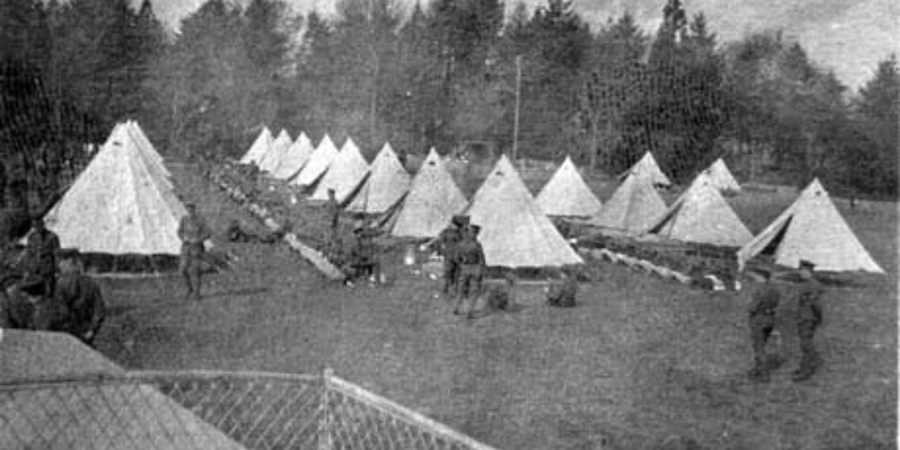Header image: Bell Tents © 2013 Trustees of the King's Own Royal Regiment Museum
Archaeologists excavating a site at Mile End, Oswestry, have uncovered evidence of a Prisoner of War (POW) camp used to house around 2,000 German prisoners during and after the Second World War. The finds uncovered shed light on the “comfortable” conditions at the camp and offer glimpses into the day-to-day lives of its inmates.
During the archaeological excavations, the team from Wessex Archaeology, working on behalf of Shropshire Council and WSP, uncovered a variety of structural evidence, which revealed a spacious camp made up of scattered barracks on a vast sports field surrounded by agricultural land. Dating of the associated artefacts and documentary evidence suggests that the camp was in use between 1940 until 1948 – several years after the cessation of hostilities in 1945.

Above: Layout of the POW camp at Mile End, Oswestry
John Winfer, Project Manager at Wessex Archaeology who oversaw excavations, said: “The study of these remains helps us to understand what life would have been like for those imprisoned in and overseeing the camp, both during the war and in the immediate aftermath. What we have revealed is surprising evidence of some (relatively speaking) comfortable conditions for the inmates.
"We know from our documentary research that the Red Cross, which visited many POW camps across Europe during the Second World War, came to assess conditions at the Mile End camp. The visit report highlights the range of facilities and activities on offer to the prisoners, which is supported by the archaeological evidence we uncovered.
"Inmates benefited from sports pitches, musical performances, electricity to power lights and heating, enough toilets available for everyone at the camp, and several hot and cold showers and wash basins, with each prisoner taking two hot baths a week. Many of the prisoners would have been employed in carpentry workshops, with younger inmates given time off to study at the camp’s school. Those overseeing the camp enjoyed more spacious accommodation, and our work uncovered military issue ceramic tableware accompanied by beer glasses. This all paints a civilised and rather unexpected picture of a POW camp.”


Above (L-R): glass bottles once containing hygiene and cleaning products, beer bottles, personal hygiene items
Despite this, archaeological evidence and documentary research also points to some minor unrest – and possibly some violence – in the camp. It was said to have been subject to ‘frequent breakouts’, and boundary ditches and fragments of barbed wire hint at the increased security arrangements.
A spent .303 cartridge reveals that a rifle was discharged at some point in the camp’s life. The presence of a loaded German pistol – thought to be a Sauer 38H pistol, a German Second World War pistol commonly issued within the Wehrmacht – found close to one of the buildings adds further intrigue.


Above: A spent .303 cartridge and a loaded German pistol uncovered at the Mile End POW camp
Artefacts have also offered more personal insights into the lives and stories of those living at the camp. A lead alloy toy camel and a make-up tin reveal a glimpse of domestic life, while containers recovered such as Brylcreem and San Izal disinfectant evidence self-care and cleanliness in the camp. One item in particular – an aluminium metal identification tag from a German soldier – has excited archaeologists, who hope to use its serial number to trace the individual and their story.
Above: A toy camel and wings from a German uniform
“This is an intriguing find with so much potential,” continued John. “These were standard issue German army items, very similar to ones the Allies used. In the event of death during the war, the tag would have been snapped, with one half buried with the body for later identification and the other given to unit administrators for recording.
"In this case, it tells us that the German POW in question belonged to the 3rd Company, Landesschützen Battalion XI/I. We know that this unit, raised from older reservists, was redesignated Landesschützen-Battalion 211 in April 1940, marking the capture of this prisoner early in the war – likely September 1939 to 1940. We know his serial number too, so we’ll be doing further research to reveal the full story – it doesn’t end here!”
Debbie Taylor, Principal Heritage Consultant from WSP, said: “The excavation has revealed valuable insights into the experiences of Prisoners of War residing in rural Shropshire during the Second World War. The archaeological work was completed on time and has now fulfilled our client’s planning requirements for the Mile End junction improvements.”
Councillor Cecilia Motley, Cabinet Member for Communities, Culture, Leisure and Tourism and Transport, said: “This is a truly fascinating find by the team working at Mile End. The artefacts uncovered by the team of archaeologists has painted a picture of life at the camp that we never knew existed.
“It seems to have been a fascinating camp, with some relatively comfortable conditions and I want to thank everyone for all the work that has taken place at the camp. We look forward to continuing investigations uncovering further insights and perhaps some indications of where the prisoners at the camp originated from.”

